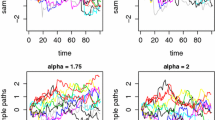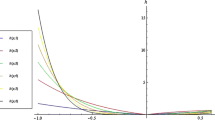Abstract
While asymmetric mixture models improve option pricing over generic pricing models, mispricing remains due to their inability to capture the effect of economic factors on price levels. This paper uses the hidden truncation normal \(\mathcal {(HTN)}\) distribution introduced by Arnold et al. (1993) and the NGARCH model of Engle and Ng (J Finance, 48:1749–1778, 1993) to price options. Compared to the Black–Scholes model, the\(\mathcal {HTN}\)-NGARCH option pricing model has extra parameters linked to economic dynamics and with economic interpretations. The model integrates some stylized facts underlying option prices such as a time-varying price of risk, non-normal innovations, asymmetry, and kurtosis. The model can be estimated by maximum likelihood. With an application to market data, we show that the \(\mathcal {HTN}\)-NGARCH model accurately prices index options and captures adequately the smirk of implied volatility.


Similar content being viewed by others
References
Amin, K. I., & Ng, V. K. (1993). Option valuation with systematic stochastic volatility. Journal of Finance, 48(3), 881–910.
Arnold, B. C., Beaver, R. J., Groeneveld, R. A., et al. (1993). The non- truncated marginal of a truncated bivariate normal distribution. Psychometrika, 58, 471–8.
Arnold, B. C., & Gomez, H. W. (2009). Hidden truncation and additive components: Two alternative skewing paradigms. Calcutta Statistical Association Bulletin, 61, 241–244.
Azzalini, A. (1985). A class of distributions which includes the normal ones. Scandinavian Journal of Statistics, 12, 171–8.
Azzalini, A., & Dalla Valle, A. (1996). The multivariate skew-normal distribution. Biometrika, 83, 715–726.
Bakshi, G., Cao, C., & Chen, Z. (2012). Empirical performance of alternative option pricing models. Journal of Finance, 52, 2003–49.
Bakshi, G., Carr, P., & Wu, L. (2006). Stochastic risk premiums, stochastic skewness in currency options, and stochastic discount factors in international economies. Journal of Financial Economics, 87, 132–56.
Barndorff-Nielsen, O., & Shephard, N. (2001). Non-Gaussian Ornstein-Uhlenbeck based models and some of their uses in financial economics. Journal of the Royal Statistical Society- Series B, 63, 167–241.
Bates, D. (2000). Post-87 Crash Fears in the S &P 500 Futures Option Market. Journal of Econometrics, 94, 181–238.
Bates, D. (2003). Empirical option pricing: A retrospection. Journal of Econometrics, 116, 387–404.
Black, F., & Scholes, M. (1973). The pricing of options and corporate liabilities. Journal of Political Economy, 81(6), 37–654.
Black, F. (1976) Studies of Stock Market Volatility Changes, In Proceedings of the American Statistical Association, Business and Economic Statistics Section, 177-181.
Bollerslev, T. (1986). Generalized autoregressive conditional heteroskedasticity. Journal of Econometrics, 31(3), 307–27.
Carr, P., & Wu, L. (2007). Stochastic skew in currency options. Journal of Financial Economics, 86, 213–47.
Christoffersen, P., Elkamhi, R., Feunou, B., et al. (2010a). Option valuation with conditional heteroskedasticity and non-normality. Review of Financial Studies, 23, 2139–2183.
Christoffersen, P., Heston, S., & Jacobs, K. (2006). Option valuation with conditional skewness. Journal of Econometrics, 131, 253–84.
Christoffersen, P., & Jacobs, K. (2004). Which GARCH model for option valuation? Management Science, 50, 1204–1221.
Christoffersen, P., Jacobs, K., Dorion, C., et al. (2010b). Volatility components, affine restrictions and non-normal innovations. Journal of Business and Economic Statistics, 28, 483–502.
Christoffersen, P., Jacobs, K., Ornthanalai, C., et al. (2008). Option valuation with long-run and short-run volatility components. Journal of Financial Economics, 90, 272–97.
Durham, G. (2007). SV mixture models with application to S &P 500 index returns. Journal of Financial Economics, 85, 822–56.
Duan, J. (1995). The GARCH option pricing model. Mathematical Finance, 5, 13–32.
Duan, J. (1999). Conditionally fat-tailed distributions and the volatility smile in options. Hong Kong University of Science and Technology.
Duan, J., Ritchken, C. P., & Sun, Z. (2006). Approximating GARCH-jump models, jump-diffusion process, and option pricing. Mathematical Finance, 16(1), 21–52.
Engle, R. F., & Ng, G. (1993). Measuring and testing the impact of news on volatility. Journal of Finance, 48, 1749–78.
Eraker, B. (2004). Do stock prices and volatility jump? reconciling evidence from spot and option prices. Journal of Finance, 59, 1367–1403.
Frühwirth-Schnatter, S. (2006). Finite mixture and markov switching models. New York: Springer.
Henze, N. (1986). A probabilistic representation of the skew-normal distribution. Scandinavian Journal of Statistics, 13, 271–275.
Hsieh, K. C., & Ritchken, P. (2005). An Empirical Comparison of GARCH Option Pricing Models. Review of Derivatives Research, 8, 129–50.
Heston, S. L., & Nandi, S. (2000). A closed-Form GARCH option valuation model. Review of Financial Studies, 13(3), 585–625.
Hull, J., & White, A. (1987). The pricing of options on assets with stochastic volatilities. Journal of Finance, 42(2), 281–300.
Johnson, H., & Shanno, D. (1987). Option pricing when the variance is changing. Journal of Financial and Quantitative Analysis, 22(2), 143–51.
Nocedal, J. , & Wright S.(2006) Numerical Optimization. Springer Series in Operations Research and Financial Engineering) 2nd Edn.
McLachlan, G., & Peel, D. (2000). Finite mixture models. New York: Wiley Interscience.
Merton, R. C. (1973). Theory of rational option pricing. Bell Journal of Economics and Management Science, 4(1), 141–83.
Nandi, S., ( 1996) Pricing and hedging index options under stochastic volatility: An empirical examination, Federal Reserve Bank of Atlanta, 96-99.
Pan, J. (2002). The jump-risk premia implicit in options: Evidence from an integrated time series study. Journal of Financial Economics, 63, 3–50.
Rombouts, J., & Stentoft, L. (2010). Option pricing with asymmetric heteroskedastic normal mixture models. CREATES, 44, 1–48.
Rombouts, J., & Stentoft, L. (2014). Bayesian option pricing using mixed normal heteroskedasticity model. Computational Statistics & Data Analysis, 76, 588−605.
Scott, L. O. (1987). Option pricing when the variance changes randomly: Theory, estimation, and an application. Journal of Financial and Quantitative Analysis, 22(4), 419–438.
Stein, E. M., & Stein, J. C. (1991). Stock price distributions with stochastic volatility: An analytical approach. Review of Financial Studies, 4(4), 727–52.
Stentoft, L. (2008). American option pricing using GARCH models and the normal inverse gaussian distribution. Journal of Financial Econometrics, 6(4), 540–82.
Wiggins, J. B. (1987). Option values under stochastic volatility: Theory and empirical estimates. Journal of Financial Economics, 19, 351–72.
Zhang, M., & Zheng, X. (2023). Numerical approximation to a variable-order time-fractional Black–Scholes model with applications in option pricing. Computational Economics, 62, 1155–1175.
Funding
The authors have not disclosed any funding.
Author information
Authors and Affiliations
Corresponding author
Ethics declarations
Conflcit of interest
The authors declare that they have no conflcit of interest.
Additional information
Publisher's Note
Springer Nature remains neutral with regard to jurisdictional claims in published maps and institutional affiliations.
Rights and permissions
Springer Nature or its licensor (e.g. a society or other partner) holds exclusive rights to this article under a publishing agreement with the author(s) or other rightsholder(s); author self-archiving of the accepted manuscript version of this article is solely governed by the terms of such publishing agreement and applicable law.
About this article
Cite this article
Belhachemi, R. Option Valuation with Conditional Heteroskedastic Hidden Truncation Models. Comput Econ (2023). https://doi.org/10.1007/s10614-023-10480-6
Accepted:
Published:
DOI: https://doi.org/10.1007/s10614-023-10480-6




